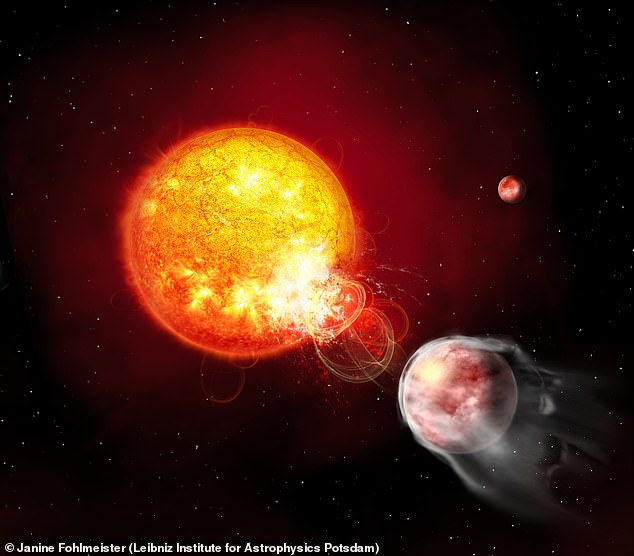
Scientists Stunned by Discovery of Self-Destructing Exoplanet: An Unprecedented Cosmic Phenomenon
Scientists Discover ‘Clingy’ Planet Sealing Its Fate with Extreme Stellar Flares
A distant “clingy” exoplanet is being stripped of its atmosphere by its host star, triggering violent flares 10,000 times more powerful than those from our Sun. The doomed planet, HIP 67522 b, orbits its star so closely that it completes a full orbit in just seven days. Over the next 100 million years, researchers predict it will shrink from a Jupiter-sized gas giant to a smaller Neptune-like world.
A Volcanic Star and Its Doomed Companion
The star HIP 67522, located 415 light-years from Earth, is a young, rapidly spinning star 17 million years old. Its intense magnetic fields interact with the planet’s orbit, creating colossal flares that erode the planet’s atmosphere. While the star is cooler and slightly larger than our Sun, its youth makes it far more magnetically active.
[Image: Artist’s impression of HIP 67522 b orbiting its host star]
Flares Fueled by Magnetic Chaos
Using NASA’s Transiting Exoplanet Survey Satellite and the European Space Agency’s Cheops satellite, scientists observed 15 flares timed precisely with the planet’s orbit. The flares occur as the planet tugs on the star’s magnetic field lines, sending energy waves crashing into the star’s surface and unleashing radiation bursts.
“The planet shakes the star’s magnetic fields like ropes, destabilizing them and causing eruptions,” explained lead researcher Dr. Ekaterina Ilin. These flares are 100 times more powerful than theoretical predictions, suggesting the planet may spark pre-existing instability in the star.
[Image: Illustration of magnetic field interactions between star and planet]
A Shrinking Future
HIP 67522 b, a low-density “cotton candy” planet, loses atmosphere six times faster due to the flares. Scientists estimate its size will diminish by two-thirds over 500 million years. While the planet won’t vanish entirely, it will transform into a denser, smaller world.
Why This Matters
This discovery supports the theory that young stars with close-orbiting planets may commonly experience such destructive interactions. Future missions like the ESA’s Plato telescope could uncover more examples. Researchers also plan to analyze flare wavelengths to assess their atmospheric erosion impact.
[Image: Comparison of Jupiter, Neptune, and the shrinking exoplanet]
Key Facts:
- Flare power: 10,000x stronger than solar flares.
- Orbit time: 7 days.
- Star age: 17 million years (vs. Sun’s 4.5 billion).
- Future mission: Plato will hunt for smaller flares on sun-like stars.
This cosmic tango highlights the dramatic processes shaping planetary systems and emphasizes the precarious balance between stars and their orbiting worlds.


